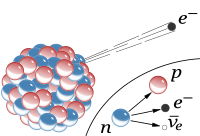Beta decay
Beta decay is an isobaric transformation of the nucleus, for this reason the number of nucleons is conserved. The nucleus is unstable due to an excess or lack of neutrons. Occurs in both ``man-made and natural radionuclides.
When compared to alpha particles, we find that beta particles are much lighter, therefore they move much faster for the same energy. When passing through the environment, they ionize and excite less. To protect against beta radiation we use plexiglass or a thin aluminum sheet.
We distinguish three types of beta decay:
- Conversion β- (emission of electrons)
- Conversion β+ (emission of electrons)
- Electron capture
Conversion β-[edit | edit source]
In the daughter nucleus, the proton number increases by 1 (ie Z → Z+1). An electron (negatively charged) and an antineutrino (the antiparticle of a neutrino, a particle from the lepton group) are emitted by the parent nucleus. The spectrum of emitted electrons is continuous.
Conversion β+[edit | edit source]
In the daughter nucleus, the proton number decreases by 1 (ie Z → Z-1). A positron (positively charged) and a neutrino are emitted by the parent nucleus. The spectrum of emitted positrons is continuous.
Electron capture (capture of an electron from an electron shell)[edit | edit source]
Most often, an electron is captured from the K shell. The proton number of the parent element decreases by 1. After the electron is captured by the nucleus, a place is freed for an electron in the lowest energy levels, and it is filled with an electron from a higher energy level. The jump of an electron in the electron shell is accompanied by the emission of a characteristic electromagnetic wave from the shell of the atom. A neutrino is also emitted by the parent nucleus.
Links[edit | edit source]
[edit | edit source]
References[edit | edit source]
- BENEŠ, Jiří, et al. Základy lékařské biofyziky. 3. edition. Praha : Karolinum, 2011. 200 pp. ISBN 978-80-246-2034-3.
- ROSINA, Jozef – KOLÁŘOVÁ, Hana. Biofyzika pro studenty zdravotnických oborů. 1. edition. Praha : Grada, 2006. ISBN 80-247-1383-7.
- NAVRÁTIL, Leoš – ROSINA, Jozef, et al. Medicínská biofyzika. 1. edition. Praha : Grada, 2005. 524 pp. ISBN 80-247-1152-4.


